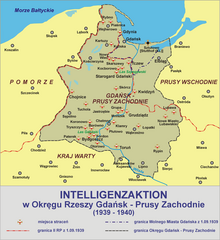Bloody autumn in Pelplin
In the bloody autumn ( Polish: Krwawa jesień pelplińska ) in 1939, almost the entire cathedral chapter of the Kulm diocese and other Catholic clergy from Pelplin were murdered.
Events
September 3 to October 16, 1939
On September 3, 1939, the German Wehrmacht occupied the town of Pelplin, two days after the attack on Poland began . Pelplin was in the former West Prussia , but was mostly inhabited by Polish people. There was the cathedral chapter of the bishopric of Kulm, the seat of the bishop, a seminary and the Catholic high school Collegium Marianum, which was supported by the bishopric.
The first clergymen were arrested from mid-September ( Maksymilian Raszeja ), the editor Jerzy Chudziński was murdered on September 20th, another two clergymen on October 16th.
October 20, 1939 On October 20, all members of the cathedral chapter and priests who remained in Pelplin were arrested by units of the SS and self-protection, a total of 21 clerics. The German cathedral chancellor Walter Schütt had been offered to leave the place, but he refused. The valuables were taken from the arrested. They were driven in rows of three out of the city into a forest and had to dig graves there. After that, however, they were ordered back to the city, possibly the Germans feared that a shooting in the forest might be too visible for the surrounding area. The prisoners were driven in a humiliating manner across the town square, beaten with rifle butts and chased with dogs. At the station they were put in a truck and transported to nearby Tczew (Dirschau).
There they were mistreated in the basement of the former barracks. That same evening 16 of them were shot dead in the barracks area.
More clergymen were killed in the weeks that followed.
Murdered clergy from Pelplin
In autumn 1939, a total of 24 clergymen from Pelplin were murdered, including almost the entire cathedral chapter (8 canons and 2 prelates), along with the directors of the seminary and the grammar school.
September 20th
- Jerzy Chudziński, editor-in-chief of the Catholic magazine Pilgrzym ( The Pilgrim )
October, 16th
- Bolesław Dąbrowski, Procurator of the Seminary, Pontifical Chamberlain
- Franciszek Baumgart, Dompoenitentiar
the 20th of October
- Juliusz Bartkowski, Provost, Official of the Spiritual Court
- Paweł Kurowski, Director of Mission Affairs, Cathedral Chapter
- Józef Roskwitalski, Rector of the Seminary, Cathedral Chapter
- Franciszek Różyński, professor of the seminary, cathedral chapter
- Maksymilian Raszeja , professor of the seminary, cathedral chapter
- Paweł Kirstein, director of the Collegium Marianum grammar school, cathedral chapter
- Bolesław Partyka, visitor for middle schools, cathedral chapter
- Jan Wiśniewski, professor of the seminary, papal chamberlain
- Alojzy Lewandowski, Provost of the Parafie (parish) Pelplin, Papal Chamberlain
- Walter Schütt, German chancellor of the diocesan curia, refused to be saved
- Jan Jankowski, Cathedral Vicar
- Augustyn Dziarnowski, Cathedral Vicar
- Jan Zaremba, professor at the Collegium Marianum high school
- Jan Sielski, professor at the Collegium Marianum high school
- Józef Grajewski, prefect at the Collegium Marianum high school
- Jan Bistram, Vicar of Parafie Pelplin
October
- Jan Bogdański, professor at Collegium Marianum high school, exact date unknown
28th of October
- Jan Cyrankowski, Dompoenitentiar
- Tadeusz Malinowski, Notary of the Diocesan Curia
- Paweł Glock, Notary of the Diocesan Curia
November 2
- Józef Smoczyński, professor of the seminary
It survived
- Bishop Stanisław Okoniewski had fled earlier
- Auxiliary Bishop Konstantyn Dominik, cathedral dean, vicar general, survived by chance
- Franz Sawicki , German cathedral provost and papal house prelate, was warned and saved
Intelligence campaign in West Prussia 1939/40
The events were part of the so-called Intelligence Action , which was aimed at eliminating Polish teachers, doctors, lawyers, priests, other intellectuals and other leading figures. These were considered to be particularly important carriers of a Polish national consciousness.
From autumn 1939 to spring 1940, around 30,000 to 40,000 of them were killed in what was then West Prussia . Two thirds of the approximately 690 priests of the dioceses of Danzig and Kulm were arrested, the rest of them went into hiding. At least 214 of them were killed. Most of those released afterwards were deported to the General Government.
Since 1945
The remains were found in Tczew on October 29, 1945. On November 15th they were buried in a common grave in Pelplin.
In 2003 the beatification of the rector of the seminary Józef Rozkwitalski was initiated. In 2009 the film Pelplińska jesień 1939 roku was shown.
In the seminary in Pelplin there is a memorial plaque with the names of the priests.
literature
- Zbigniew Talewski: Martyrologia księży pomorskich . In: Naji Gochë . No. 11. 2002
Web links
- Bloody autumn in Pelplin war crimes 1939–1945 (German)
Individual evidence
- ↑ Adam Bloch: Sliwicki Proboszcz. Maksymilian Raszeja (1889-1939). In: Kociewski Magazyn Regionalny . No. 4 (31), with detailed descriptions of the events up to October
- ↑ Maksymilian Raszeja Chełmno.info (German)
- ↑ List of murdered clergy from 1939 Parafie Pelplin, 2008 (Memento, Polish)
- ↑ Short biographies of 16 from October 20, 1939 St. Zygmunt Słomczyn parish, Martyrologium (English)
- ↑ Short biographies of other clergymen from Pelplin parish St. Zygmunt Słonczym, Martyrologium (English)
- ^ Jochen Böhler , Klaus-Michael Mallmann , Jürgen Matthäus : Einsatzgruppen in Poland. Presentation and documentation , Wissenschaftliche Buchgesellschaft, Darmstadt 2008, ISBN 978-3-534-21353-5 . Other authors assume similar figures.
- ^ Martin Broszat : National Socialist Poland Policy 1939–1945. Deutsche Verlags-Anstalt, Stuttgart 1961, p. 44 .


